

This diary first appeared in PC Gamer magazine issues 379 and 380. We do one every month, taking on new challenges and approaching our favourite games from entirely new angles—and letting you know how we got on.
Since its release in 2015, Cities: Skylines has received 35 DLC packs. Granted, some of these are either content-creator packs or song-bundles for the in-game radio stations, but even if you discount them, it would leave 11 full-blooded expansions for Colossal Order’s landmark city-builder.
I’ve always wondered what the game looks like with everything installed, how the expansions collectively change the vanilla experience. Does it simply result in a bigger city, or do the expansions fundamentally alter how those cities feel and act? More importantly, does all that extra stuff make for a superior, more fulfilling experience, or does it simply make the game cumbersome and overcomplicated? Well, after making the UK PR for Cities Skylines cry, I’ve got every major expansion installed, and I’m not afraid to use them.
Part One
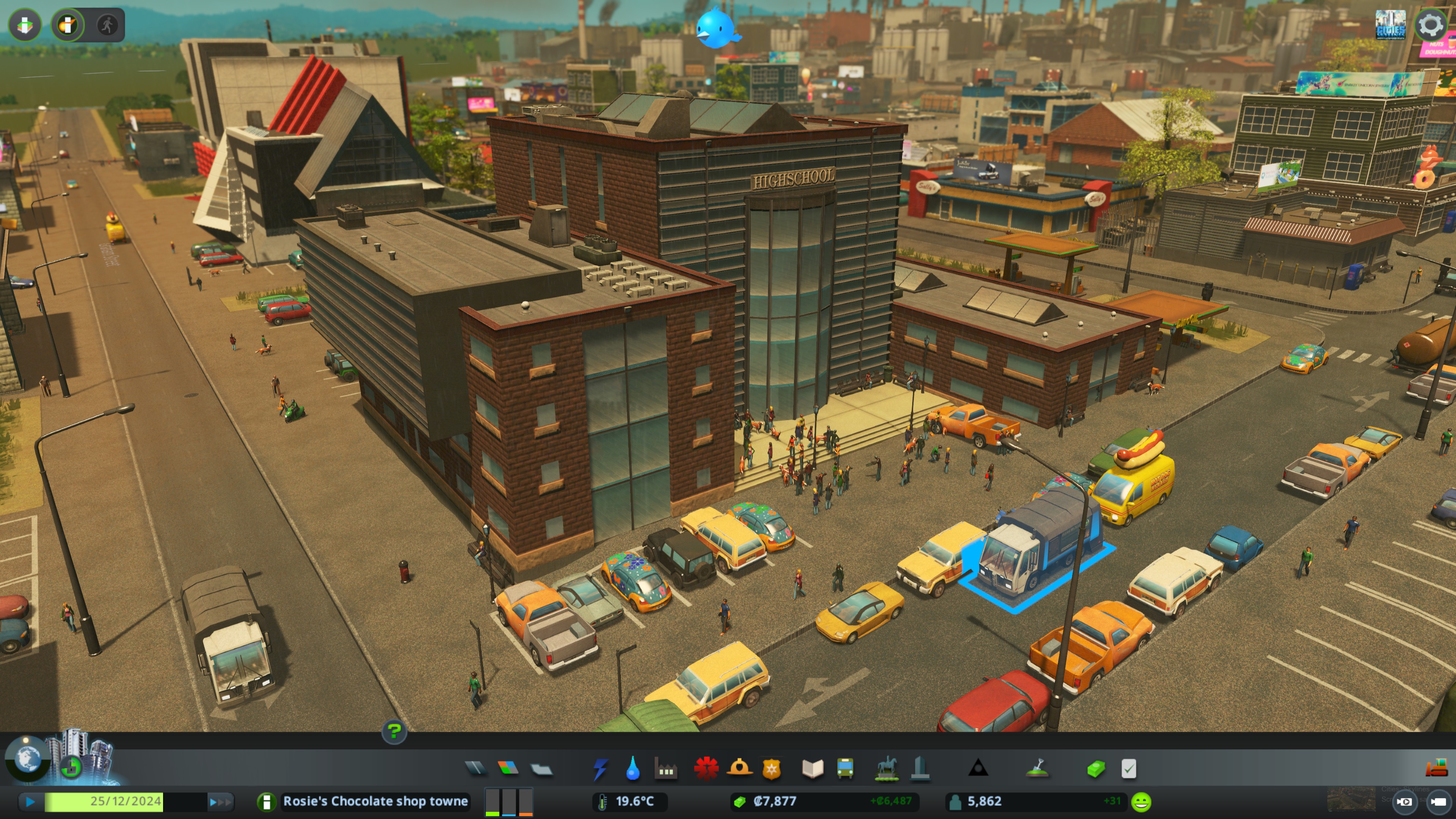
1. Play the game with normal rules.
2. Attempt to build every building.
3. Disasters on.
Before we break ground on this new metropolitan project, we need to do a little admin. I’m playing Skylines on the standard game mode, with no alterations to the rules. For the map, I pick the first one on the list—Asanu Beach—as I want a typical example of a Skylines map, with no extremes one way or another. Finally, every feature of every expansion is enabled by default, which is a roundabout way of saying that disasters will be switched on, and I’ll have to deal with whatever catastrophes the game throws in my direction.
Getting started is always one of the trickier moments in a Skylines game. Your opening funds can run dry quickly, and it’s easy to overspend by making your initial layout too big. So I keep things simple, drawing a long, two-lane road and looping it back around to reconnect with the highway, then evenly distributing residential, commercial, and industrial zoning along it. Starting with a two-lane road may cause problems farther down the line, but at least it keeps costs down.
I spend the next hour or so methodically expanding the three respective zones to grow the town and start unlocking some specialised buildings. There is a slight snag with the map I’ve chosen, as it only gives me access to a tiny slice of the nearby river, which makes establishing infrastructure for water and sewage a little precarious. I could build water towers and a treatment plant (and I will have to eventually) but right now I don’t want to deal with the faff of either, and carefully place a water pump and an effluent pipe on the riverside.
With the basic amenities sorted, I start with the basic services. Schools, medical centres, small police, and fire stations. This is always a wonderful moment in Skylines, when you watch your emergency services roll out onto the street for the first time. It’s also enhanced by Skylines’ first expansion—After Dark. The simulated sunsets and night-time contribute massively to the game’s atmosphere, especially when your city’s darkness is illuminated by the red and blue lights of emergency vehicles.
It isn’t long before another expansion makes its presence felt, as my fledgling city is afflicted by its first disaster. A sinkhole yawns open just off the city’s main thoroughfare, swallowing several houses. Frankly, it’s less of a disaster and more of a nuisance, as I spend several minutes figuring out the terrain tools to refill the gulf in the landscape. Still, it’s a timely reminder that disaster could strike at any moment, so my next building project involves a disaster response unit and a small radio mast, the latter of which will better forewarn me of impending catastrophes.
Keep up to date with the most important stories and the best deals, as picked by the PC Gamer team.
Grow home
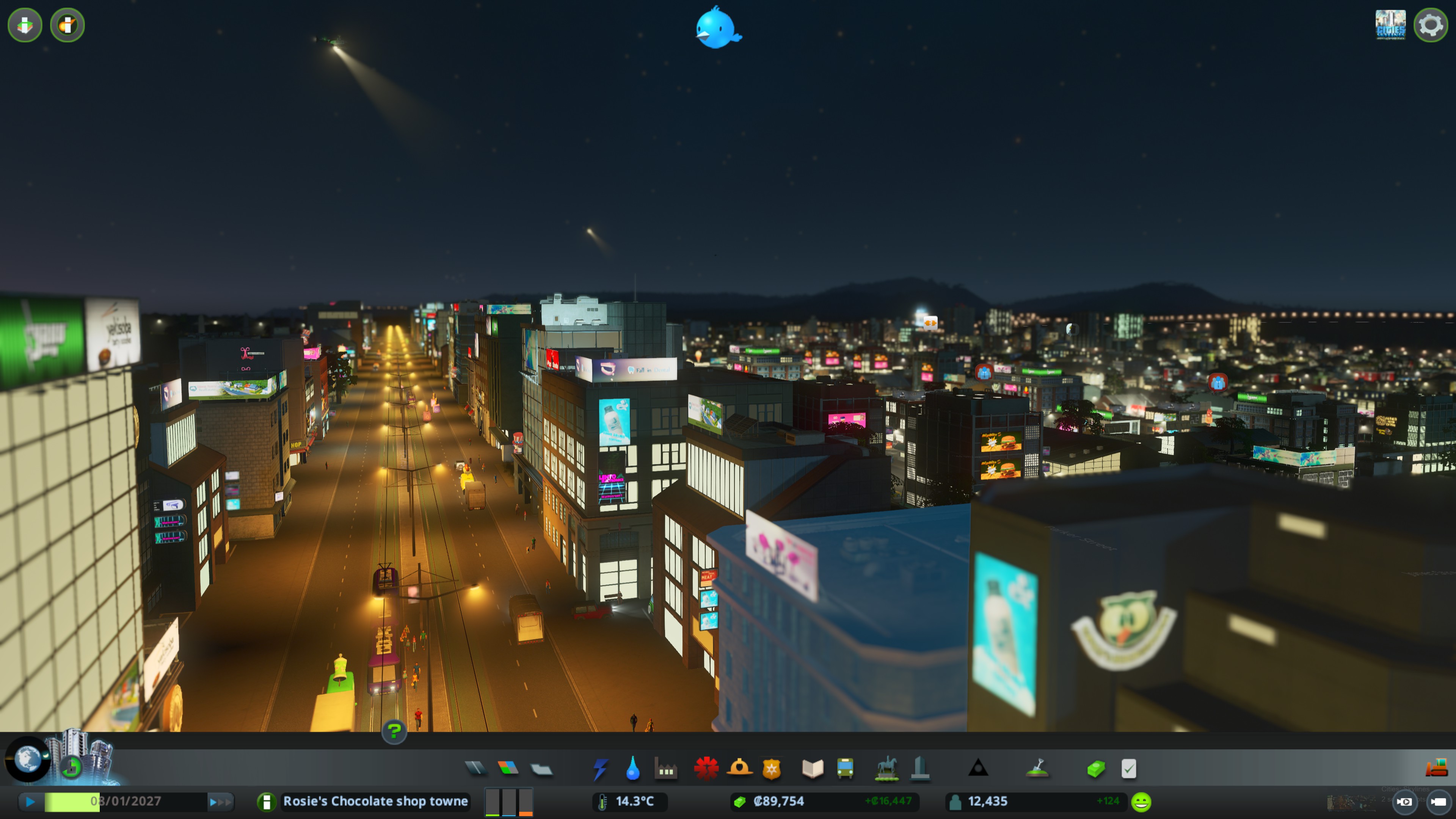
Once all this disaster prep is finished, I have to twiddle my thumbs for a bit while I wait for my town to reach its next growth phase. I decide to spend that time renaming a few of the streets. My daughter, who is flitting between watching the game’s fire engines and climbing up the back of my office chair, suggests I name the main thoroughfare ‘Sesame Street’. Concerned about getting in trouble for trademark infringement, however, I opt for the safer, if less catchy ‘Legally Distinct Children’s Show Street’. My daughter is thoroughly unimpressed, so as compensation, I allow her to name the city whatever she likes. Which explains something you might be able to make out in the screenshots.
With the basics of my city laid out, and my funds having recovered a little. I start to think about which of the many different industry specialisations I want to explore. Initially, I opt for fishing, but this quickly proves to be a terrible idea. As I mentioned, I only have access to a small stretch of river, into which my sewers are currently pumping enough effluent into to make Britain proud. In addition, while the river goes brown, I’m trying to make my city more green, supplementing its one coal power station with aquatic wind turbines. Between the poo and the power, the river has enough space for exactly one small fishing wharf. Not exactly destined to be a money spinner, especially given what they’re likely to be fishing out of my extremely brown river.
What I want to do is buy enough land to reach the attractive-looking beach on the far side of the peninsula, then build a nice little tourist trap. But I can’t really justify that right now. Between my city and the beach, however, is a large stretch of open woodland ideal for starting a forestry industry, which is what I opt for. Specialised industries in Cities Skylines are based around production chains, implementing which takes a little figuring out [see boxout]. Weirdly, starting the chain requires me to build plantations. Talk about not being able to see the forest for the trees.
I’m interrupted from my industrial efforts by the announcement of another impending disaster. My disaster response headquarters has detected signs of an earthquake, one measuring 2.6 on the Richter scale. This is less powerful than a truck driving past your house, so I’m not especially worried. But my seismologists must have read their instruments while doing handstands or something, because when the earthquake does come it wrecks the joint. Buildings across the city start toppling like UK Prime Ministers, while a chasm opens up in the centre of my city that’s so huge I half-expect demons to pour out of it. The earthquake also severs my two main roads from the highway, which in Skylines is the equivalent of having your throat slashed.
On the roads
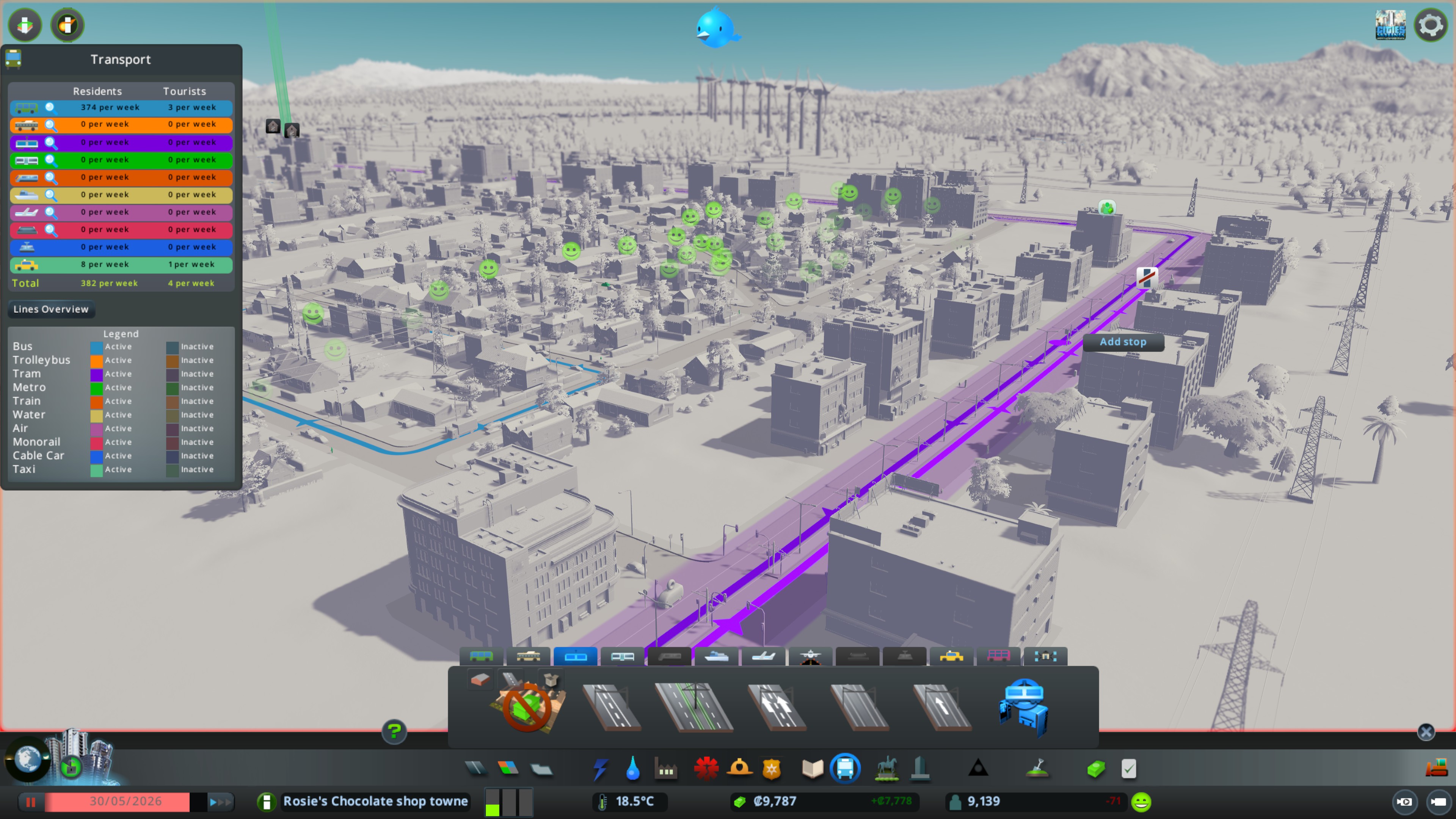
All of this takes considerable time to fix. Demolishing all the ruined buildings is straightforward, if laborious. But the real headache is fixing the roads. Not only has the earthquake destroyed my main thoroughfares, it has also damaged the highway junction itself, and junctions are one of the fiddliest things to build in Skylines. My attempt to fix it is akin to a triple-bypass surgery performed by a chimp, but after a considerable amount of shrieking and throwing faeces around the operating theatre, the traffic starts flowing again.
I follow-up the disaster with additional contingency planning, sprinkling the city with local disaster shelters, and adding helicopter bases for the police and the ambulance service. At least, that’s my officially stated reason for doing this. The real reason is that helicopters are cool, and I love watching them whirr above the city as they go about their business.
Adding the helicopters tickles my vehicular tastebuds, and I opt to spend the next hour overhauling my city’s transport networks. I start by adding a taxi service and a bus depot, and establish several bus routes connecting to my industrial district, which is struggling to get the workers it need. I then make the risky move of upgrading my main street from two lanes to four. The reason this is risky is it’ll basically destroy half of my main commercial area. But the congestion is becoming unmanageable, so I’m hoping it’ll be worth the temporary dip in income.
Next, I start building a tram line that I intend to service a newly-built city centre with high-density commercial zones. This proves much more complicated than I imagined. In Skylines, tramlines have to be circular, which is not how trams generally operate. This means I must direct the tram along Legally Distinct Children’s Show Street. In other words, I have to re-lay the four-lane road I’d just placed.
When activated, the trams naturally trigger a cascade of congestion issues that take an age to mitigate, in the end requiring me to add a second junction to the highway. Ultimately though, the lovely purple trams chiming their way through the city makes this all worthwhile. Once my logistical rejigging is complete, I decide to have a little break and pretty the place up a bit, I add a few plazas to the commercial area, and sprinkle the residential zones with dog parks and children’s play areas.
“Is that a play park?” my daughter asks over my shoulder. I zoom in to let her watch the virtual kids play on the virtual swings. At that exact moment, a pair of paramedics wheel a stretcher with an extremely dead-looking peep on it right through the middle of the park. Cities: Skylines, traumatising both real and imaginary children since 2015!
Industrial action

Leaving this macabre scene, I decide to check-in on how my forestry industry is doing. The short answer is ‘it’s on fire’. The long answer is unprintable. It appears one of the logging buildings went up in flames, and the fire quickly spread to the surrounding woodland, resulting in a sprawling inferno. In retrospect, I probably should have built a fire station somewhere in the vicinity, given the long-standing affiliation between logs and fire. At one point, it looks like the blaze will reach the main urban centre of my city, but a timely rainstorm helps douse the flames before they can do any serious damage.
With another crisis narrowly averted, my final act of the session is to lay down some office zoning, and commence work on building a specialised campus area for the city. I say ‘specialised’—it turns out the Campus expansions add a lot of different types of campus you can build, which are entirely separate from the game’s existing university, arts college, and technology institute. So what I end up building is a specialised area for general higher- education. I’m sure that won’t confuse anyone.
Surveying my work, I feel like God on the sixth day, insofar as I probably should have started the creation process by doubling the number of days in the week.
While I’ve dabbled with most of the expansions over the course of the session, I’ve also barely scratched the surface of any of them. I underestimated how many new buildings each one adds, and neglected the fact that building every building will mean adding ones that I don’t want or need (such as fossil fuel-based power stations). Nonetheless, I’m hugely impressed and inspired by the game’s scope and possibility even within the small amount I’ve experimented with so far. Building absolutely everything is going to be a long haul, but it’s a haul I’m very much looking forward to pulling.
Part Two
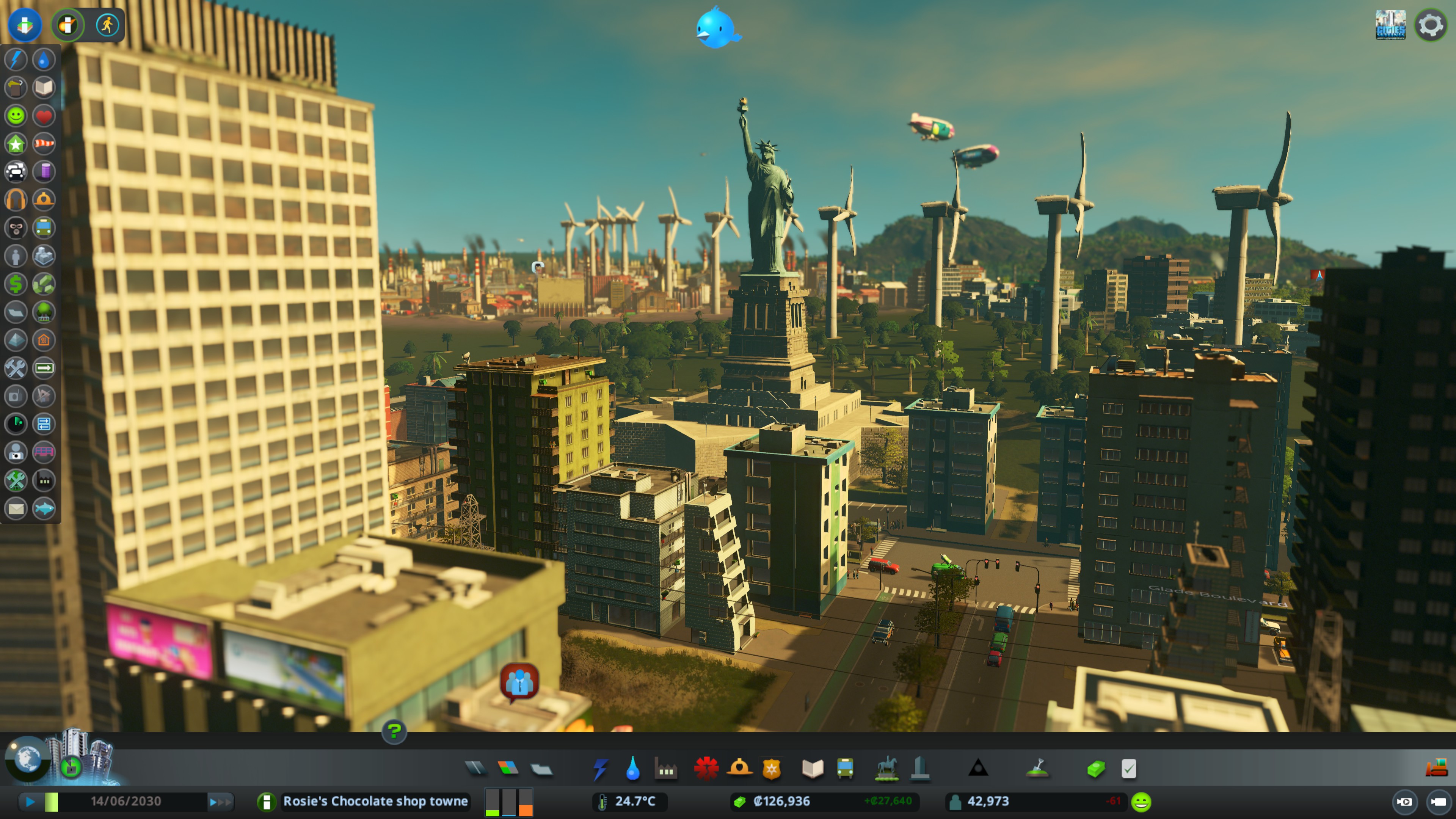
When I last left off my attempt to build every building in Cities: Skylines, I had established a modest yet thriving town (despite several forest fires and one devastating earthquake). I had also sorely underestimated just how many buildings there are in Colossal Order's metropolitan megahit, especially when you add all the official expansions into the mix. Naturally, my first job for this month was to add even more buildings into the game, via the content creator packs.
For those unfamiliar with Skylines' vast library of expansions, alongside the major DLC created by Colossal Order itself (such as After Dark, Green Cities, Sunset Harbour and so forth) is a range of secondary DLC that features user-created content. This includes new structures themed around European cities, Japanese architecture, airports, modern city centres, there's even one pack that adds extra vehicles to the game. If I had my work cut out for me before, my boss has just thrown away the scissors and demanded I use my teeth.
In which case, we'd best crack on. As a quick reminder, I'm playing Cities: Skylines with the standard ruleset, which with the Natural Disasters expansion added means those are switched on. Toward the end of last month's diary, I'd been inching my city toward the shoreline, with the aim of building a glitzy tourist trap across those pristine beaches. But as Skylines boots up, I decide I'm tired of waiting for my city to catch up with me, and leap right into building virtual Benidorm.
To reach the sparkling arc of vanilla coastline that lies north of my city, I lay a long four-lane boulevard stretching toward the beach, then unspool a curving two-lane road across the waterfront itself. I then create a new commercial district that covers both roads and designate it as a 'tourism' district. Well, initially I set it to 'nightlife' by mistake, which leaves me confused when I return later to find the waterfront filled with nightclubs and arcades rather than swanky hotels.
As scaffolding appears across the coast, I fill in the gaps with more specific tourist attractions—fishing huts, fishing piers, fishing... islands? A lot of fishing stuff basically. I then set to work on my main attraction for the tourism district, an amusement park. Yes, Cities: Skylines lets you play a little game of Rollercoaster Tycoon inside itself, designing a little carnival complete with rides, café's, gift shops, and fuzzy animal mascots one cartwheel away from suffering heatstroke.
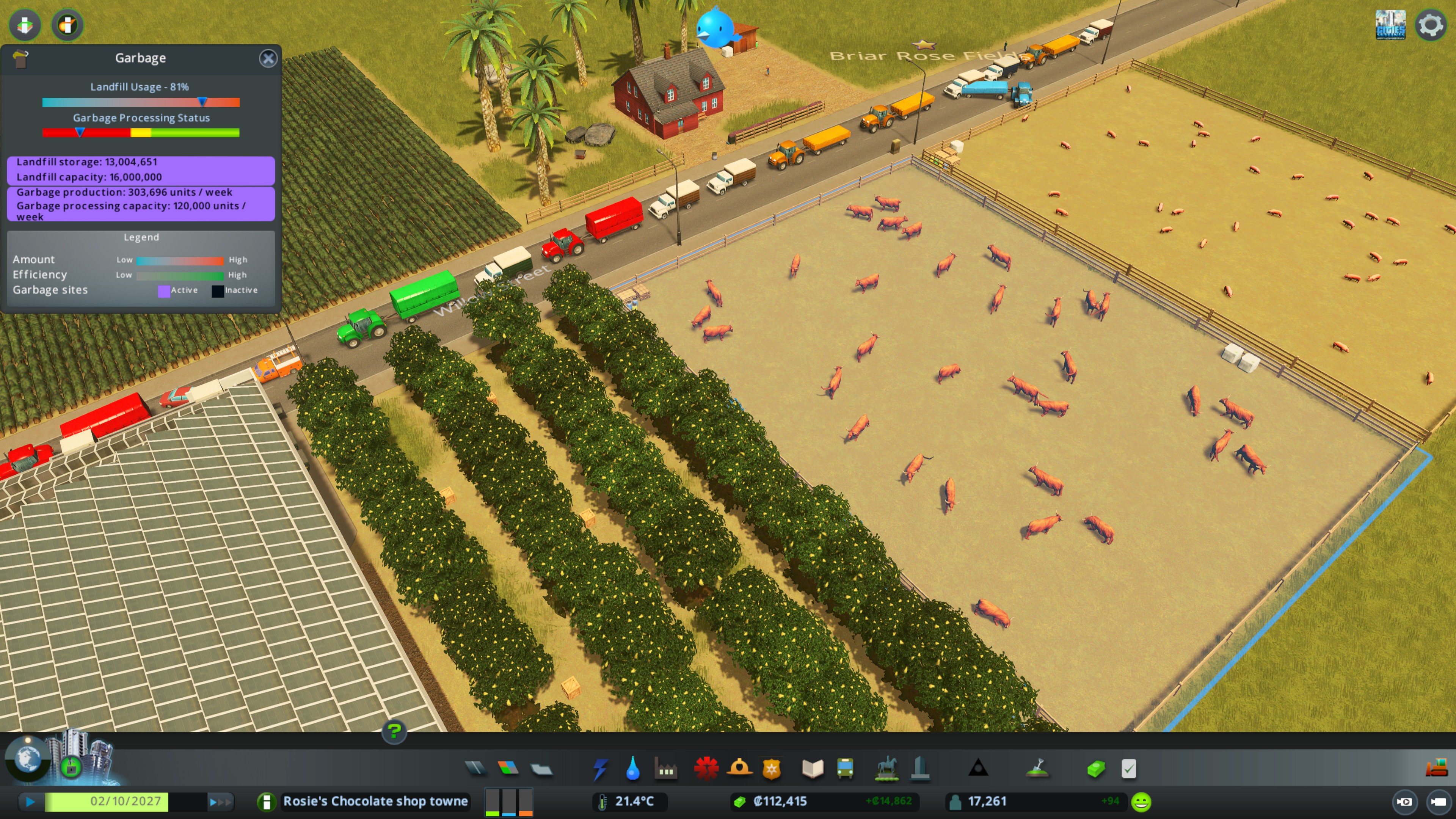
I can't express how excited I was about building a theme park inside the city I had also built. What other game lets you do that? Unfortunately, it wasn't as much fun as I anticipated. See, you only get a handful of basic rides to begin with, unlocking others by increasing the park's reputation. Hence, on its grand opening, my main seaside attraction was less like the Magic Kingdom and more like Skegness.
Overall though, I'm happy with how my tourism district has turned out. Sure, the massive pool of shit billowing out from nearby effluent pipes is a bit of an eyesore, but a few water-treatment plants and a couple of offshore garbage collectors will soon have all that pollution cleared up. Satisfied, I pull away from my newly created hedonist haven, and return my attention to the bulk of my city. Oh God.
A sea of incredibly angry-looking icons stretches out before me. Business aren't getting enough workers, abandoned structures are littering the town, noise pollution is literally deafening my citizens, sickness is rife, and dozens of corpses fester in their homes. A fire has also broken out at my furniture factory, and there are no fire engines in the vicinity.
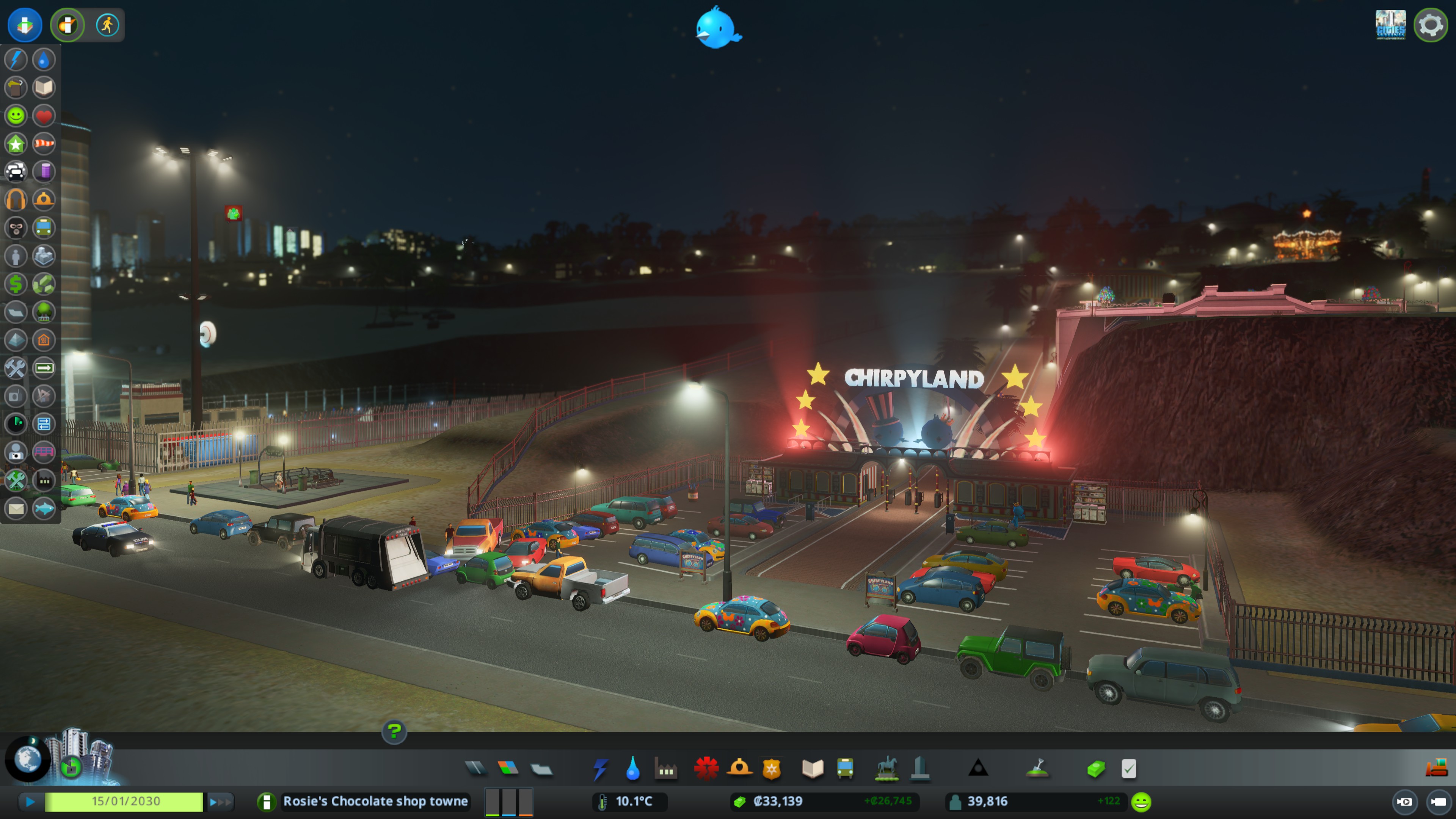
The city has grown substantially in my absence, with demands on core services massively exceeding supply. I spend the next half-hour redressing the balance, finding space for more schools, medical centres, fi re-stations, and graveyards. Once that's done, I add a couple more specialised industries into the city. On one side, a lovely farm raising crops and livestock like sheep, pigs, and—weirdly specific—highland cows. On the other, a filthy dirty oil complex. Look, I'm trying to build every building, including those I might morally object to.
Spread zeppelin
Once the service crisis has abated, I sweep back to my tourism district to see how things are progressing. The district itself is bustling, but my theme park has attracted a pathetic ten visitors in the last week. My YouTube account attracts more visitors than that, and the most watched video on there is of an iceberg in Skyrim. The problem is location; the park is right at the end of the strip, with no transportation links to it aside from the road. I need to grease the wheels of my city a little. But how?
I ponder several possibilities. A new tram line? Trolleybuses? A monorail perhaps? I'm leaning toward monorail, because as anyone who has watched Marge vs the Monorail will know, they are cool and safe. But then I see something better, something I'm sure Marge would have zero objections to. Blimps.
Yes, Cities Skylines lets players build transportation networks for that most practical of vehicles, the small, speedy, and not at all ostentatious blimp. Before you can say "Hindenburg disaster" I've got a whole network of blamptey blumpers cruising above the city. And I thought the helicopters from the last diary were cool. Helicopters ain't shit. It's blimp time baby.
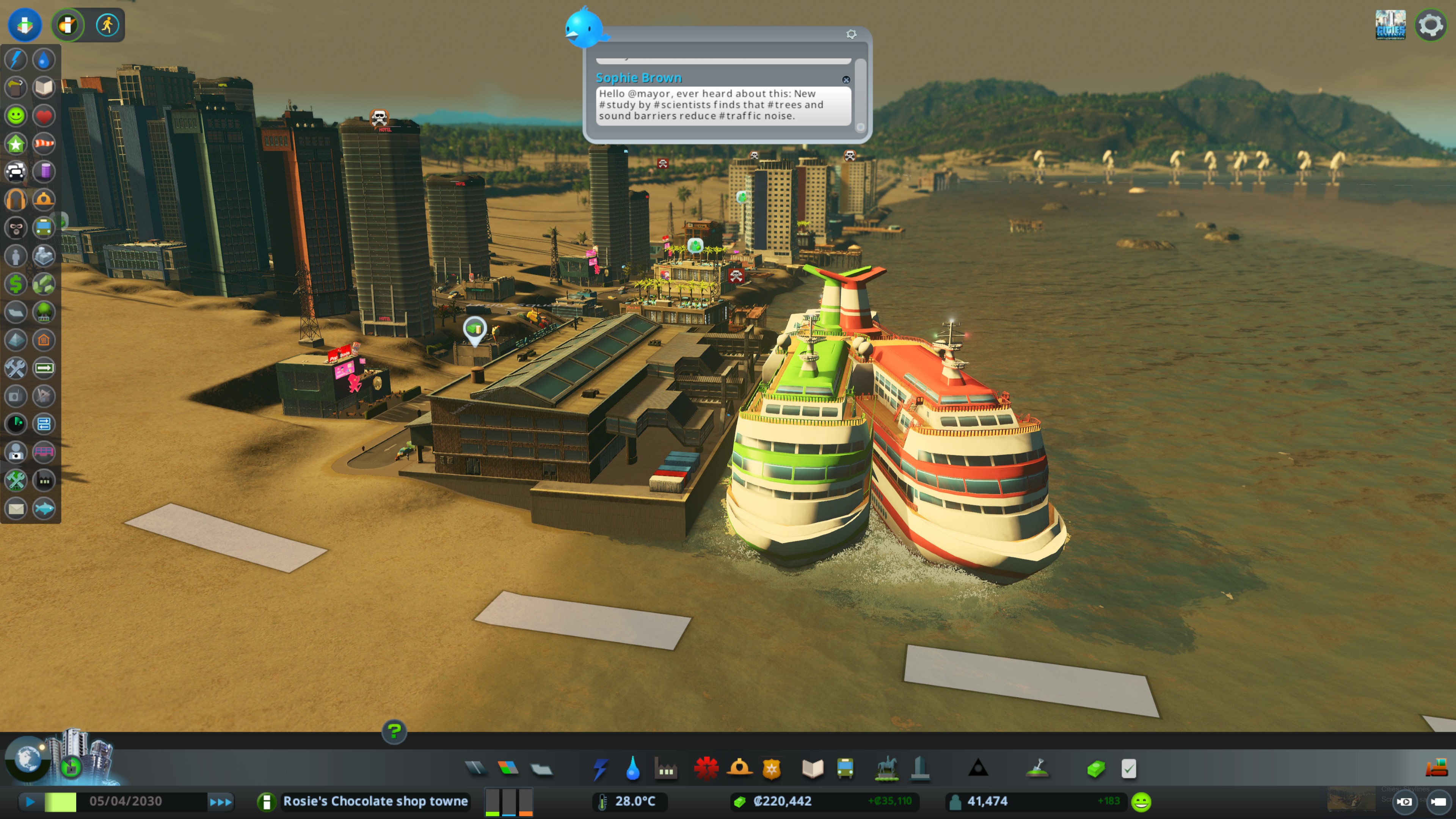
OK, I'll admit it. Although a giant pink balloon is the most fitting way to arrive at an amusement park, a transportation system comprised entirely out of blimps probably isn't the most efficient way to increase footfall to Chirpyland. So I start a project I should have started ages ago, building a citywide subway system with a station right beside the theme park. This takes a while as building miles of underground railway is flipping expensive. But I'd have to build one at some point anyway, so I might as well do it while it can benefit the city.
With this complete, I do some new zoning and another round of service expansion—including the construction of a preppy liberal arts academy where the children of my city's millionaires can while away their formative adulthood pretending to be socialists. I then turn my attention to my next major project, a zoo, which I place halfway between my tourism district and the city centre in a possibly over-thought attempt to lure people toward my amusement park like the witch in Hansel and Gretel. Again, the opening options are a little underwhelming, an antelope enclosure and a birdhouse. But if it helps draw people toward my increasingly lucrative tourism district, I don't mind laying down some cash on a few boring animals.
Shortly after this, we get the session's first disaster—another earthquake. Luckily, the epicentre is near the corner of my city, far removed from its main bulk. The relief lasts for precisely two seconds, when I spot my income plunging farther into the red than Geralt of Rivia on a contract. It turns out the earthquake has wrecked my industrial district, and I've got minutes to fix it before my city goes bankrupt. I hurriedly take out nice fat loan to balance the books while I clean up the mess and reconnect all the roads. At least it wasn't my tourism district, I'd be in real trouble if anything happened to that.
Cruise control
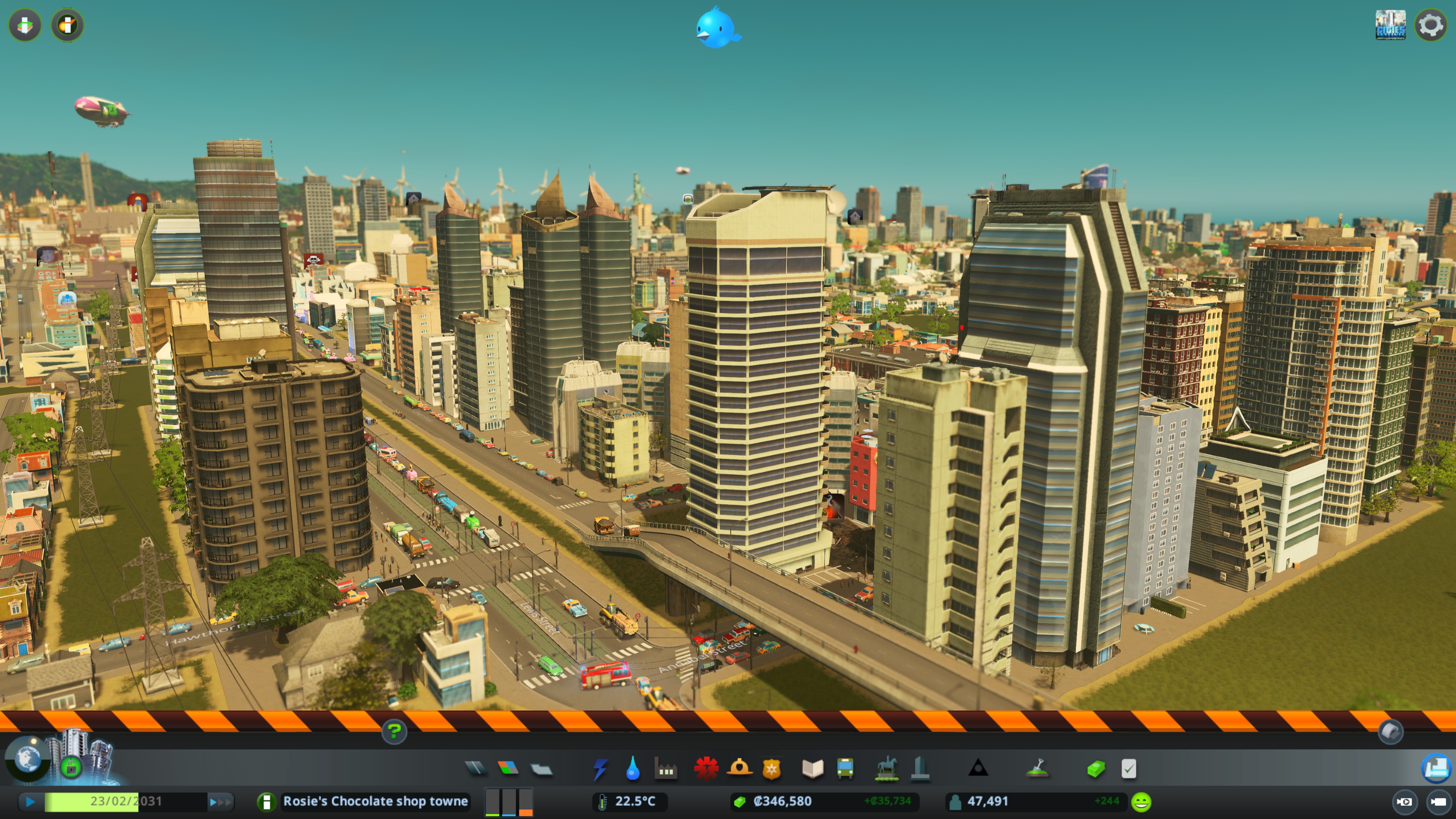
As I'm clearing up the last pile of rubble left by the earthquake, I unlock a building I've had my eye on for ages—the harbour. This brings in tourists from outside your city via cruise ship, ideal for someone who has spent several hours obsessing over their tourism district. I place the harbour the near corner of the strip. Immediately, half a dozen cruise ships appear in the ocean and dock at the harbour, stacking inside one another like Russian dolls.
It's a bizarre sight. Speaking of bizarre, while I'm watching the cruise ships dock, I notice that the tourism district's fire station has an exceptionally high crime rate. How does a fire station become rife with criminal activity? What are they doing in there, running a fire engine chop shop? An unlicensed pole dancing club? It's very strange, but nothing a police station won't fix.
At this point my city is 'raking it in', as the economists say. To celebrate, I head to the unique buildings tab and start slamming down monuments and other mighty structures. The statue of liberty, several phallic financial institutions, a lush central park, another zoo that's unrelated to the zoo I already built. I dedicate a chunk of virgin land to building a new arts complex, complete with a stadium, a festival centre, an opera house, and an aquarium (the latter because I couldn't fit it into the tourism district). I then build a tech hub that I childishly dub 'Silly con valley', and establish a space centre that includes both a rocket-pad and a space-shuttle platform (which I believe is from one of the content packs, although at this point it's all blurring together).

I'm laying down buildings like Kanye West lays down questionable life choices, but I'm slowly realising how futile my task is. There are tons of unique structures that I can only unlock by meeting specific criteria, while the same goes for the specialised industries and parks. It's also dawning on me how little these new buildings are affecting the broader experience. Structures like the zoo are fun to add for the sake of aesthetics, but few outside of transport or utility buildings dramatically impact the feel or function of a city.
I'm beginning to feel despondent when, finally, my amusement park upgrades, and I get to add spinning teacups and a weird pig ride to the park. It may not be much, but it lifts my spirits. Soon, that rollercoaster will be mine! That's when I get the warning for the tsunami.
I say 'warning'. The alert arrives at the exact same time as the tsunami. This is possibly my fault, because I neglected to build the tsunami early-warning system. But let's not go casting aspersions, eh? In any case, holy seawater, Batman, Colossal Order wasn't messing about when designing these tidal waves. The towering hotels of my tourism district are submerged by the surging ocean. Vehicles float away, entire streets are flattened by the crushing pressure. My beloved amusement park is destroyed. Not a single building survives.

For my city, it's an absolute mortal blow. The destruction of my tourism district rips a gaping hole in my economy, and the game begins warning me of potential bankruptcy before the water has even subsided. I try to plug the hole with a loan, but I'm still paying off a much bigger loan I took out with that earthquake. It's like throwing a penny into a well.
But I'm not going out on anybody's else's terms. What nature started, I intend to finish. I open up the disasters tab, select 'meteor', and point that giant space rock right at the heart of my city. Moments later, my financial district collapses in a flash of celestial fire. I completely failed to build every building in Cities: Skylines. But on the plus side, I murdered lots of investment bankers. I consider that a win.
Rick has been fascinated by PC gaming since he was seven years old, when he used to sneak into his dad's home office for covert sessions of Doom. He grew up on a diet of similarly unsuitable games, with favourites including Quake, Thief, Half-Life and Deus Ex. Between 2013 and 2022, Rick was games editor of Custom PC magazine and associated website bit-tech.net. But he's always kept one foot in freelance games journalism, writing for publications like Edge, Eurogamer, the Guardian and, naturally, PC Gamer. While he'll play anything that can be controlled with a keyboard and mouse, he has a particular passion for first-person shooters and immersive sims.

